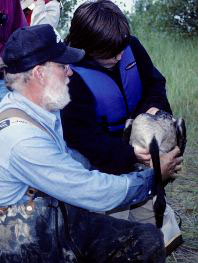Mississippi River Wildlife
The Upper Mississippi River is home to a diverse assortment of wildlife that finds habitat in its backwaters, sloughs, wetlands and bottomland forest.
Mississippi River wildlife management

Mississippi River wildlife technician and young assistant banding Canada geese.
The Mississippi River team works closely with other conservation agencies along the Mississippi River, particularly the U.S. Army Corps of Engineers, U.S. Fish and Wildlife Service and the adjoining state Departments of Natural Resources to manage and monitor wildlife. Citizen groups also play an important role.
Mississippi River wildlife monitoring results
Although Wisconsin DNR personnel survey several species of wildlife on the river, the two surveys which receive the most attention are the waterfowl aerial survey and the midwinter bald eagle count.
Waterfowl aerial survey results
Each week during fall migration, biologists fly the Mississippi River to count the number of waterfowl using Pools 4-13 of the refuge. Due to survey techniques, the number of waterfowl counted only provides trend information, which is not necessarily the total number of waterfowl in a specific pool.
Midwinter Bald Eagle survey
A survey of wintering bald eagles on the Mississippi River from La Crosse to Dubuque, Iowa is conducted each January. The route is continuous and conducted from a fixed-wing aircraft.
Mississippi River hunting and trapping information
Where is it legal to hunt with a Wisconsin license?
You may hunt with a Wisconsin hunting license only in open hunting areas within Wisconsin. The commercial navigation channel, marked with large red or black buoys, is the state line in most places. A few exceptions exist where the main channel of the river was moved by the U.S. Army Corps of Engineers after the Wisconsin state line was established.
Hunting opportunities
Although hunting opportunities for deer, squirrels and wild turkeys are present along the Mississippi River corridor, waterfowl receive the most attention from hunters. The Mississippi is one of Wisconsin’s best waterfowl hunting destinations due to an abundance of public land, great scenery and good numbers of ducks. Waterfowl foods are most abundant in the area from Trempealeau to Lynxville (Pools 7, 8 and 9). As a result, these areas harbor the most ducks. They are also the most heavily hunted areas along the river.
Boating requires caution
Boaters should pay especially close attention to the wind and other weather conditions, particularly in late fall if they are traveling on large areas of open water. Numerous stumps and other navigation hazards are also present, so boaters need to be more careful than on lakes or deep marshes.
